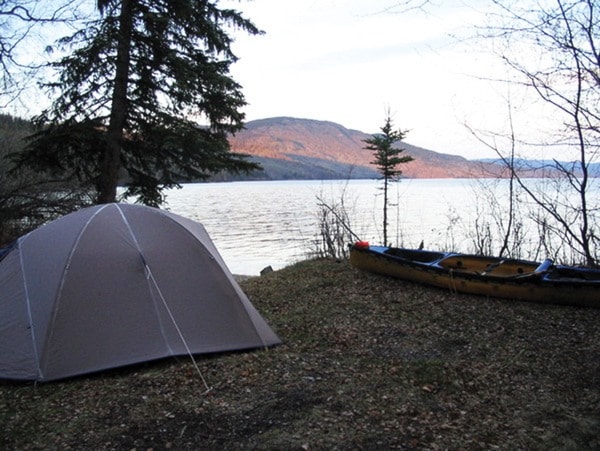With spring still refusing to walk through the front door, not many people were thinking of camping back on March 15, the date that B.C. Parks started taking online reservations for campsites across the province.
In addition to these provincially maintained, fee-for-use, sites, there are many smaller forest recreation sites throughout the province. In Northern B.C., these small, rudimentarily equipped campgrounds are typically free to use.
There are 30 recreation sites, seven trails and two parks (Ethel F. Wilson and Pendleton Bay) in the Lakes District and on the Southside.
In 2002, the province had plans to possibly decommission many of the sites. In response, an agreement was reached between community stakeholders and the province wherein B.C. Parks and the Ministry of Forests, Lands, and Natural Resource Operations (MFLNRO), would continue to contribute resources to the recreation sites. The Lakes Outdoor Recreation Society (LORS) was formed to take over the maintenance of the sites and has completed two, five-year partnership agreements since then.
“We maintain them from the week before May 24 to the week after Labour Day,” said Lynn Synotte, LORS president. “We hire two contractors. They mow the grass and do minor brushing and weeding. They also monitor the rec. sites and do minor repairs to picnic tables and outhouses.”
The annual LORS budget requirements come in at around $50,000. This year, LORS was facing a major funding shortfall, with only $14,000 in the bank.
Previously, LORS was able to rely on the Burns Lake Community Forest for the majority of its funding. This year the management structure of the community forest is in the midst of reorganization that won’t be complete until after the summer season has begun, precluding the possibility of a financial commitment.
As a result, Synotte had been looking for other sources of funding.
Just when things were starting to look grim for LORS, the province stepped in with a $20,000 commitment through MFLNRO. At the same time, the Burns Lake Bulkley Valley Credit Union stepped up with a $10,000 contribution.
Synotte said that LORS and its directors were, “thrilled, and relieved, at receiving this funding as it means maintenance costs are essentially covered for this year. We are still in need of about $6,000 but we are so close to our target, it’s a huge load off our shoulders.”
Kevin Eskelin, district recreation officer for the Nadina-Skeena Recreation District explained that despite the difficulties in funding that LORS faced this year, the local recreation sites were never in danger of being unexpectedly closed.
“Funds are very constrained,” said Eskelin. “But those sites aren’t at risk of closing or being disestablished.”
“We want LORS to be fairly autonomous in their own management,” he added. “We like to see communities raising funds to the greatest of their ability, but we’ll come in and make sure that everything is in place.”
The Nadina/Skeena recreation district covers a swath of territory from Kitwanga and Gransile in the north, to south of Houston and eastward to Ootsa lake. It includes over 75 campsites, 15 trail networks and dozens of hiking trails. Eskelin works with 15 different groups like LORS throughout the district.
Partnership agreements with local user groups should not be seen as a way for the province to get out of funding local recreation amenities, but the reality is, there’s only so much money to go around.
“Something always gives,” said Eskelin. “For example, if we only had to give $5,000 to LORS instead of $20,000, then that’s $15,000 that would be available for another partner group.”
There’s no guarantee that money available in this year’s provincial budget will be there in the next budget. Although the province was able to step in this year and cover the gap in funding, that isn’t a long-term solution.
“My main concern is future sustainability,” said Eskelin. “ We don’t know what kind of a budget we’ll have in five years for the sites, so we try to find other relationships and arrangements along the way. Most often, we engage with not-for-profit groups at the community level.”
The next step for LORS, said Synotte, is to increase the membership base so that LORS is eligible for more grants. For example, a potential source of funding is the B.C. Lottery gaming grant, but LORS was ineligible to apply this year because it doesn’t have enough non-director members.
“We have to have twice as many members as directors at the annual general meeting,” said Synotte.
The next annual general meeting is May 16, 2013. Synotte is hoping that a membership and funding drive will get people signed up as regular, non-voting, LORS members.
As well as new members, LORS will be looking for corporate and private donations to cover this year’s remaining funding gap. As part of their funding drive, a ‘Like LORS’ campaign has started. Supporters of the program would be acknowledged through signs placed at trailheads and campsites.
“We [LORS] do a really good job,” Synotte said. “People are supportive in the area, including the ministry of forests and the Burns Lake Community Forest.”
But if that community support can’t be translated into cash for operations, then LORS will have to keep turning to the province to bridge funding gaps.
With that comes the insecurity that surrounds any program governed by budget constraints.
